NewburyportIn their annotated edition of The Shadow Over Innsmouth, S. T. Joshi and David E. Schultz quote a letter in which HPL describes his first visit to Newburyport. In his time, it was a veritable ghost town, and the atmosphere of civic decay was one of the primary inspirations for Innsmouth; though in the story, the two places are clearly distinguished from each other. Today, Newburyport is a quaint and charming seaport town, busy and well-maintained but boasting more buildings and neighborhoods of antiquarian interest than any other place I visited. The drive up the 1 from Danvers to Newburyport was a nearly straight cut through green forest that had mostly not yet begun to change colors for the autumn. I should mention that just about every ten feet in Massachusetts you will find a construction crew doing repairs on the road. Standing next to each road crew are one or two police officers with the silliest-looking, wide-brimmed blue hats, whose job apparently consists of waving by cars that would surely have driven by anyway without their help. Another oddity of driving in Massachusetts is their penchant for avoiding stops. This habit reminded me of the English, who will put in six roundabouts and mark every street in town as one-way in order to avoid having to put in a stoplight. In Massachusetts there were a few roundabouts, but the more common trick was to post a flashing light, in one of three colors. A flashing red light is presumably like a stop sign, and a flashing yellow light probably meant "Yield" or "Caution," but I never quite figured out what a flashing green light was supposed to convey. In practice, the local drivers seems to treat all these colors the same way, as if they meant "Speed up so the cross traffic won't be tempted to turn in front of you." (By the way, as a Californian I found myself wondering what you call someone who lives in Massachusetts. A "Massachusettsian"?) |
|
State Street
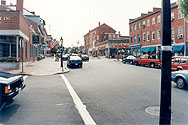 |
As you reach the town of Newburyport, Highway 1 turns into State Street. There is free parking on the waterfront on Merrimac Street, less than a block west of State Street on the right hand side. There is a tourist information booth by the lot, but this booth was closed when I arrived, so I decided to set off eastward along the waterfront and return later for the information. This information booth never opened on the day I was there. An alternative information source is the Chamber of Commerce, on the east side of State St. a block or two from the river. (Donovan Loucks has reminded me that you can't take State Street straight through to Merrimac, as State Street becomes one-way in the wrong direction. It appears that you could turn left on High Street and right on Green Street to get to Merrimac.) |
|
I quickly encountered some riverside warehouses and a crumbling stone wharf ("the ideal place for a long secret colloquy"). The harbor was studded with sailboats and fishing vessels. After a while, the path merged with Water St. which continues along the shore. According to the map, Newburyport harbor is partly filled with sand, like Innsmouth, but it was difficult to tell; though tall reeds line the waterfront, they don't extend out very far. |
|
| Shortly thereafter I turned inland and made my way through neighborhoods where almost every single house reminded me of the Haunted Mansion ride at Disneyland. (A comparison that sheds a pretty sad light on my upbringing!) | |
A Friendly Cat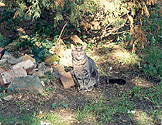 |
I found a park with a beautiful fountain, and a gray cat, the first of several friendly cats and dogs that I was to encounter in Essex county. (Curiously, they were less so elsewhere in New England. In Providence they would pose, but not come close. In Boston, I saw no cats at all!) |
First Parish Burying Ground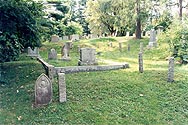 |
Next was a beautiful cemetery, in fact my favorite of those I encountered on this trip; looking at the map now, I think it must have been the First Parish Burying Ground. |
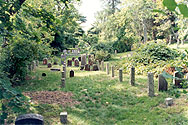 |
The rear portion descends into a deeper twighlit region of ancient family plots and markers. The border overlooked a pond of some considerable sylvan beauty. |
|
|
Returning to the main portion of the graveyard, I perched precariously on a narrow tombstone to get a good shot of a decaying old white steeple looming over the scene. Such ornate old steeples dominate the skyline at many points in Newburyport, and show a considerable variety in their style and ornamentation. |
Cushing House Museum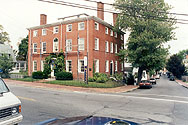 |
At some point I chanced upon the Cushing House
Museum, which Donovan Loucks states is "also known as the Historical
Society of Old Newbury, and Lovecraft refers to as the Newburyport
Historical Society." Unfortunately, this cannot be the building
visited by the Shadow narrator, as it was not acquired by the
Society until the late 1950's, having been a private residence up to that
point. One wonders where the Society's headquarters were located back in
the 1920's.
A kindly and knowledgeable guide took me through the extensive displays, which encapsulate the social and economic history of the region. Once the major shipbuilding center on the East coast, Newburyport declined when the ships got too large for their narrow port entrance; only to revive briefly during and after World War II, and then return to a depressed state in the 1950's and 1960's. According to the guide, they started fixing the place up again in the 1970's, and since the 1980's it has been fairly successful. While regretting the consequent loss of atmosphere, I could not help being glad that they had found some prosperity again. The basement includes a room with a carved figurehead called the Landlocked Lady (because it never went to sea). Supposedly the jewelry worn by this figure inspired Lovecraft's description of the exotic R'lyehian gold jewelry on display at the museum his narrator visits. It just goes to show the transforming power of inspiration, since the Landlocked Lady is about the most prosaic figure you will ever see, and the jewelry painted on her is both small and nondescript. (By the way, this room is apparently now a standard part of the tour, though Loucks mentions having to ask specially to see it when he visited.) Cushing House was my first encounter with an annoying policy of New England museums and historical sites (or maybe it is just those managed by the S.P.N.E.A., Society for the Preservation of New England Antiquities), which is that they don't allow photography inside, even non-flash photography. Nor do they sell much in the way of postcards or brochures with pictures of the interior. You're pretty much left to memorize the displays you see, or to forget them, as the case may be. One of the most amusing characters described by the tour guide was a Lord Timothy Dexter, a wealthy and extremely eccentric man who built a large mansion in Newburyport and filled the yard with tall pillars, on each of which was a painted wooden statue of one great patriot or another. Contemporary engravings show that the place made a truly tacky impression. Apparently Dexter, whose title was a mere fanciful affectation, once staged his own death and lay in a coffin in the parlor to observe how much grief the visitors would show. He finally sat up and began to upbraid his wife for not crying more. |
Masonic Temple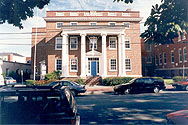 |
Sites of Lovecraftian interest in Newburyport include the white-pillared Masonic Temple on Green Street. Donovan Loucks tells me that it was Will Murray who took this to be the inspiration for Lovecraft's Esoteric Order of Dagon Hall. (Loucks, along with Joshi and Schultz, opts for the Legion Memorial Building in Gloucester instead.) The Knights of Columbus building at the corner of State and High Streets also looked to me like a promising branch church for Dagonites to assemble. |
Newburyport Public Library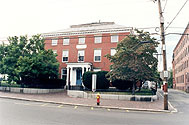 |
The Newburyport Public Library on State Street is where the Shadow narrator attempted to research Innsmouth history. It is a venerable old building whose managers are desperately trying to raise money for restoration. |
| Market Square (actually a triangle), where State Street dead-ends into Merrimac and Water Streets, was the place where the Shadow narrator caught Joe Sargent's bus for Innsmouth. The whole downtown region around there is composed of ancient brick buildings, and one can appreciate Lovecraft's surprise at discovering that it was still the main center of commerce for the town. | |
| The Merrimac river apparently inspired the Manuxet in Shadow, but unlike the fictional river, is free from waterfalls. The bridges are not so numerous as those in Innsmouth, but the old Chain Bridge that I took out to Deer Island was memorably rickety; each passing vehicle makes the whole thing shake like it's ready to fall down. Deer Island also afforded a nice view of the river. | |
|
Next I drove east to Plum Island, to try to get a better view of the harbor entrance. Imagine my surprise at finding Joe Sargent's bus, or at least its first cousin, parked on a side-street there. It was a battered bluish-gray heap parked under a basketball hoop, and the "Free Leonard Pelletier" bumper-sticker surely signaled the Deep Ones' sympathy with oppressed indigenous populations everywhere. It was a long sandy walk out to the southern breakwater, and one devoid, so far as I could tell, of "cabins, dories, and lobster pots." There was a decaying wharf, but then, aren't all wharves decaying? The breakwater, a long pile of beslimed rubble, looked like a likely spot for eldritch beings from the deep to gather, though at the time I visited it was populated only by a lone fisherman. |
|
|
Contents Previous: Arrival Next: Essex Coastline Return to Cthulhu Mythos home page Send comments to jfm.baharna@gmail.com © Copyright 1997-2021 by Joseph Morales |
|